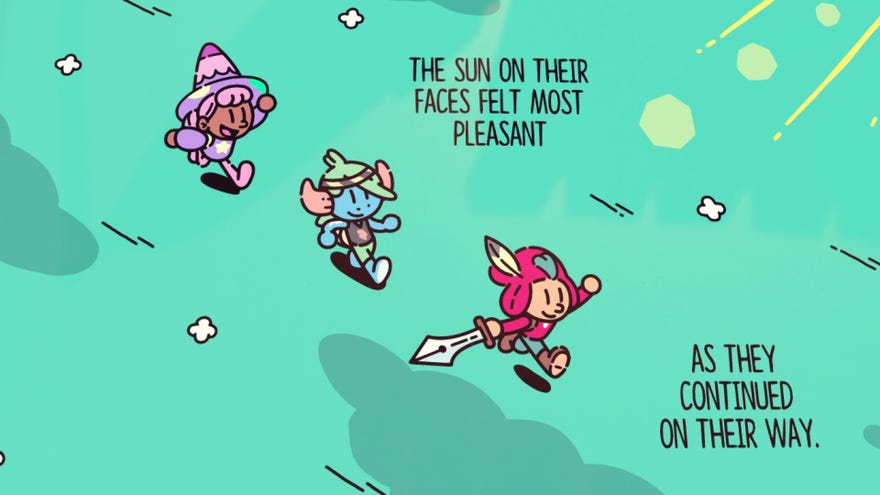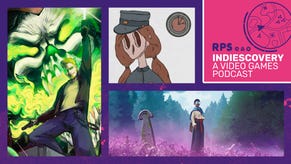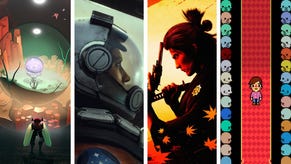The Plucky Squire review: a charming storybook adventure, but I wish it let you go full plucko mode
Up all night to get plucky
I really wanted to like action adventure The Plucky Squire more than I do now, having given its charming 2D to 3D platforming a proper whirl. Yes, it's lovely to look at. Yes, hopping out of a storybook and making friends with an illustration on a coffee mug is cool. And yes, everyone can have a mildly fun time with its puzzles and fights. But that's the problem: who is everyone? At first I thought, "This game is for young kids and that's fine!", given its relative simplicity. Then I hit some puzzles and thought, "Ain't no kid figuring this out".
Then it hit me. It struggles to balance the fine line between being approachable for tiny tots and layered enough for people who've graduated from "goo goo ga ga" to "oo oo aa aa my back hurts". And that's down to how plucky you're allowed to squire at any given time, because it can be surprisingly limited and, sadly, a bit underwhelming.
The Plucky Squire sees you play as Jot, an adventurous little lad who's joined by his friends Violet and Thrash. They live inside a storybook, and as the pages turn, it tells the tale of how an evil wizard called Humgrump is defeated by Jot. But for a mysterious reason, Humgrump defies his fate by ripping Jot out of its very pages with some never before seen magic. From then on, you must put a stop to Humgrump's nasty plans by coveting treasures outside of the storybook and using them to manipulate its pages.
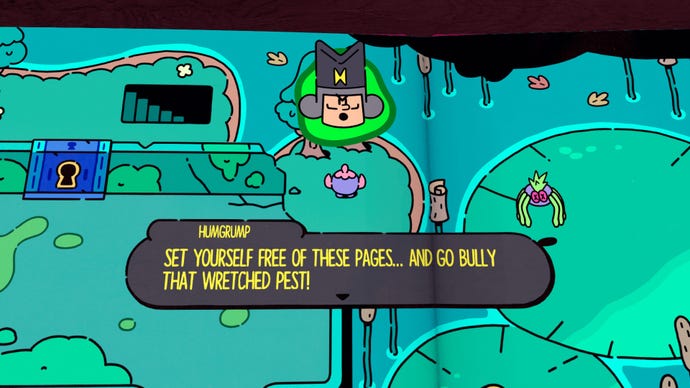
What's clear right away is how wonderful it is that the adventure's laid out, quite literally, as a kid's book flipping its pages. A calming narrator's voice lays out what Jot and his pals are up to, as illustrations spring to life on a surface so detailed the sheen of the ink reveals the high quality GSM it's overlaid on. Everyone and everything is drawn in a pleasing manner, that's colourful and round and very, very merchable. If there's one thing this game nails, it's presentation - I rate it gawgeous out of ten.
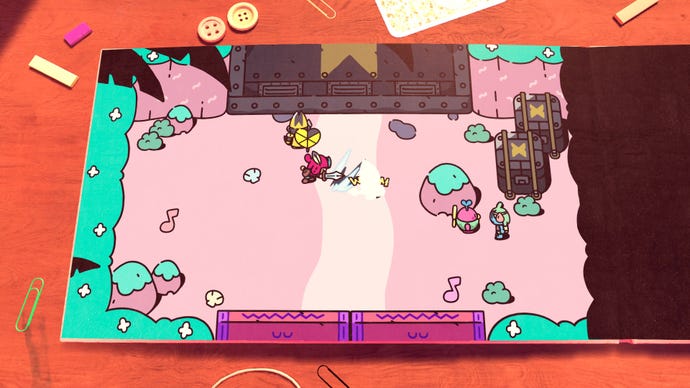
Presentation, though, isn't everything. As I'm unsure whether children with prune thumbs and/or soiled diapers would care much for Jot's tale, nor parents who might play it alongside them. I know pacing is naturally a bit slower given it has to lock page turns behind video game stuff, but even still, it's a story that lacks those clear, concise, moral teachings of timeless bangers like The Rainbow Fish or The Very Hungry Caterpillar.
Maybe I'm looking into it a bit too much as some grumpy adult, but Jot and his pals mostly mosey through worlds, do some puzzles, and fetch things for people only so they can stop Humgrump… whose badness I think manifests as a sort of "ruining the environment is bad kids" message later on. The same cloudy messaging goes for the extremely messy kid whose room you clearly all inhabit, and who seemingly helps you along by constructing levels out of cans and toy blocks and pencils (more on this in a sec). Cheers, I guess?
Story aside, early on your adventure is confined to the pages of your storybook. It's a bit of dodgerolling and basic bashing with your sword, maybe some hopping across platforms, the usual sort of thing. Not long after your encounter with Humgrump, however, green swirly portals let you spring out from the page and into the 3D realm, with a transition that's smooth and an aesthetic that's also lovely on the eye. And whenever the game lets you do so, you're then able to wander over the book and actually flip back and forth between pages.
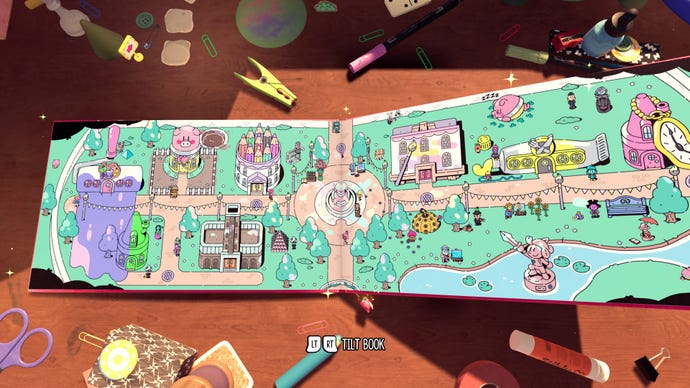
Why? Because then you can make use of Jot's best ability, which is to cut highlighted words out of sentences and repurpose them in others. For instance, you could grab the word "cheese" from somewhere, then plop it into a gap you've carved out of a sentence like, "A block of ____ sat in the corner" to lure a raging rat out of his lair so you can safely shuffle past. These puzzles are some of my faves, as it feels like you're frankensteining story beats to overcome obstacles. Combine this ability with that page-flipper and you've got a recipe for some interesting stuff! When you flip pages back and forth in the 3D realm, a page will thrum with light if there's a helpful word in there. Clever, isn't it? This means you can cleave words out of previous pages, then bring them into the current page you're on.
As you try and foil Humgrump's plans, you'll travel through all sorts of funky spots, like an ascent up a mountain filled with metal-loving mice and a beach home to a rotund bird called Tumbo, who exists purely to dig and believes that all problems can be solved with a shovel. One of my favourite locales is an artsy world, filled with cute renderings of famous artists like Van Gogh and Picasso and Dali and many others who say jokes I don't get the references in. And it's here where you're encouraged to leave the pages again and take on one of few 3D set pieces.
These are, essentially, structures built by the mysterious kid. These involve some platforming and some light puzzling, as you use blocks as booster pads for traversal. Complete the challenge and you'll earn a special ability that'll let you further manipulate the pages of the book. These are some of the game's best bits, as you hide from beetles in stealth sections (the kid is unhinged and lets beetles run amok in his room as his "pets"), or use trading cards propped up against blocks as means to scale them in 2D, before hopping out in 3D once you've reached their peak. Sometimes, though, you're given time-extending guff, like when a sentient jelly asks you to light six candles scattered around the table because that's the only way he'll give you whatever item he has. Boo.
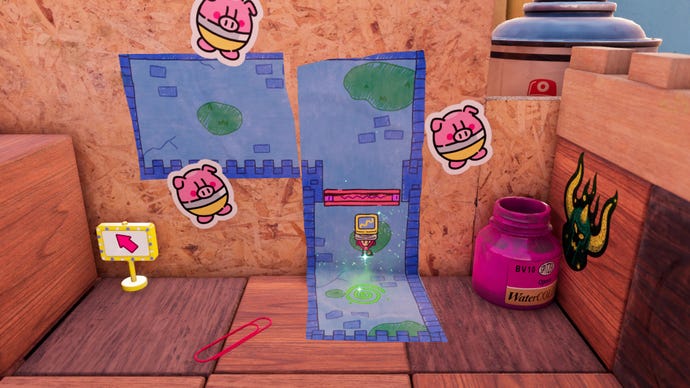
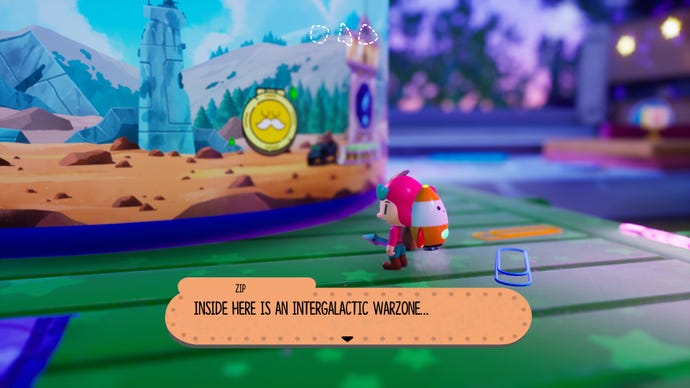

Still, these are somewhat balanced out by bespoke bits that'll have Jot partake in some off-piste activities. Like battling an elven archer inside her domain: a legally distinct Magic The Gathering card. Or circling around a galaxy-themed mug as you take up arms with a laser pistol and shoot ships in a bullet hell. While they're undeniably a cheek lifter, I can't help but feel like they're also short lived and rather basic. The fight against the elven archer is turn-based (cool!), but it's entirely on rails (...oh). The bullet hell arcadey bit? Yeah, it's middling and nothing more than it needs to be. The prize after each of these things is always a new toy to further tinker with the storybook's pages and overcome Humgrump's pesky hurdles.
These range from gloves that'll let you tilt pages of the book to make things slide or roll, to stamps that'll let you generate bombs in the 2D realm or freeze items in place. Combined with your previous word-chopping and page-flipping abilities, you'd think that the game's transformed your Jot into a Swiss Army pen of the editorial world; so maximally plucked, none of Humgrumps antics will get in the way of your creativity. Unfortunately, this isn't the case.
That's not to say there aren't puzzles that don't make you feel clever, like when you tilt the page to unplug a gap, or place a bomb in the 3D space, so it drops onto a pressure plate in the 2D realm. Trouble is, the game gives you so many powerful, world-altering abilities, that it needs to restrict what's available to you within each puzzle scenario. This means that, yes, you and/or your kid might be less overwhelmed while playing - a positive. Yet, it also strips a lot of the organic puzzle-solving or creativity out of each solution.
For instance, there was one puzzle where I had to drop bombs from the 3D realm into the 2D realm so they'd land on pressure pads that would unlock doors or generate platforms from the walls. In short: I tried using my special Stop Stamp to freeze a platform in place, so when I returned to 2D realm I could hop onto it and exit the level. Nope, didn't work. Instead I'd overlooked a different bit with a box I could use to activate another plate. I thought my solution was better!
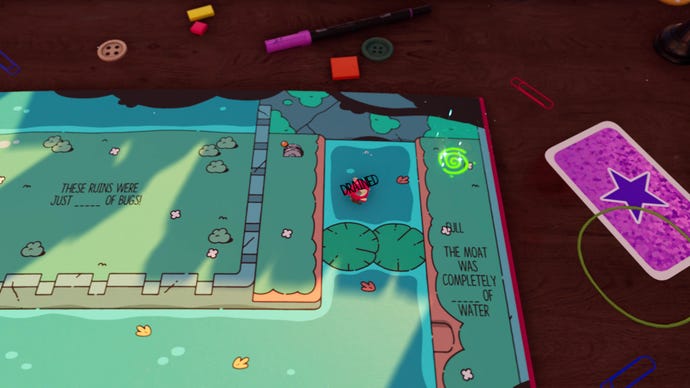
There are other times where the solution is a bit open-ended, like "Go and find someone", and so you whip out your mental clipboard and tick off what abilities you think the game doesn't want you to use. In the end, I became reliant on this ever-present mini Moonbeard who gives you strong hints to solve each puzzle, because I'd fear I'd overstep each puzzle's specific win conditions with my own solutions. Or simply because I didn't trust the game's cues.
Not to bang on about it, but seriously, there were a few too many times I simply didn't pick up on the solution the game was feeding me. I'd acquire an ability and it wouldn't immediately enter my internal toolkit, like how puzzler Cocoon builds them into your muscle memory with some cleverly crafted environmental hints. And don't get me started on the number of puzzles that had me stumped because the swirly green portals that let you enter the 3D realm hadn't appeared until I happened to wander close.
I do feel a bit bad about ragging on The Plucky Squire, a game that's ultimately a fairly fun, inoffensive time and absolutely meant for people who aren't as ailing as me. Its energy is great and upbeat and lovely - a perfect balm in the face of today's horribleness. But I do think it suffers from trying to do lots of things and getting a bit lost within them (for what it's worth, I think it would've done better fleshing out the word-chopping ability, as it really can feel magical sometimes). The combat is fine, the platforming is fine, mostly everything feels just fine. And necessary restrictions on your ability usage means that you're always hunting for a one-note solution, as opposed to feeling like you're really altering the narrative. Even games 'meant for kids' still have those deeper layers beneath the simplistic surfaces, where the creativity of teens aren't underestimated and the oldies can flex their mastery muscles. Scratch away the ink and I don't think there's much beneath The Plucky Squire, sadly.
